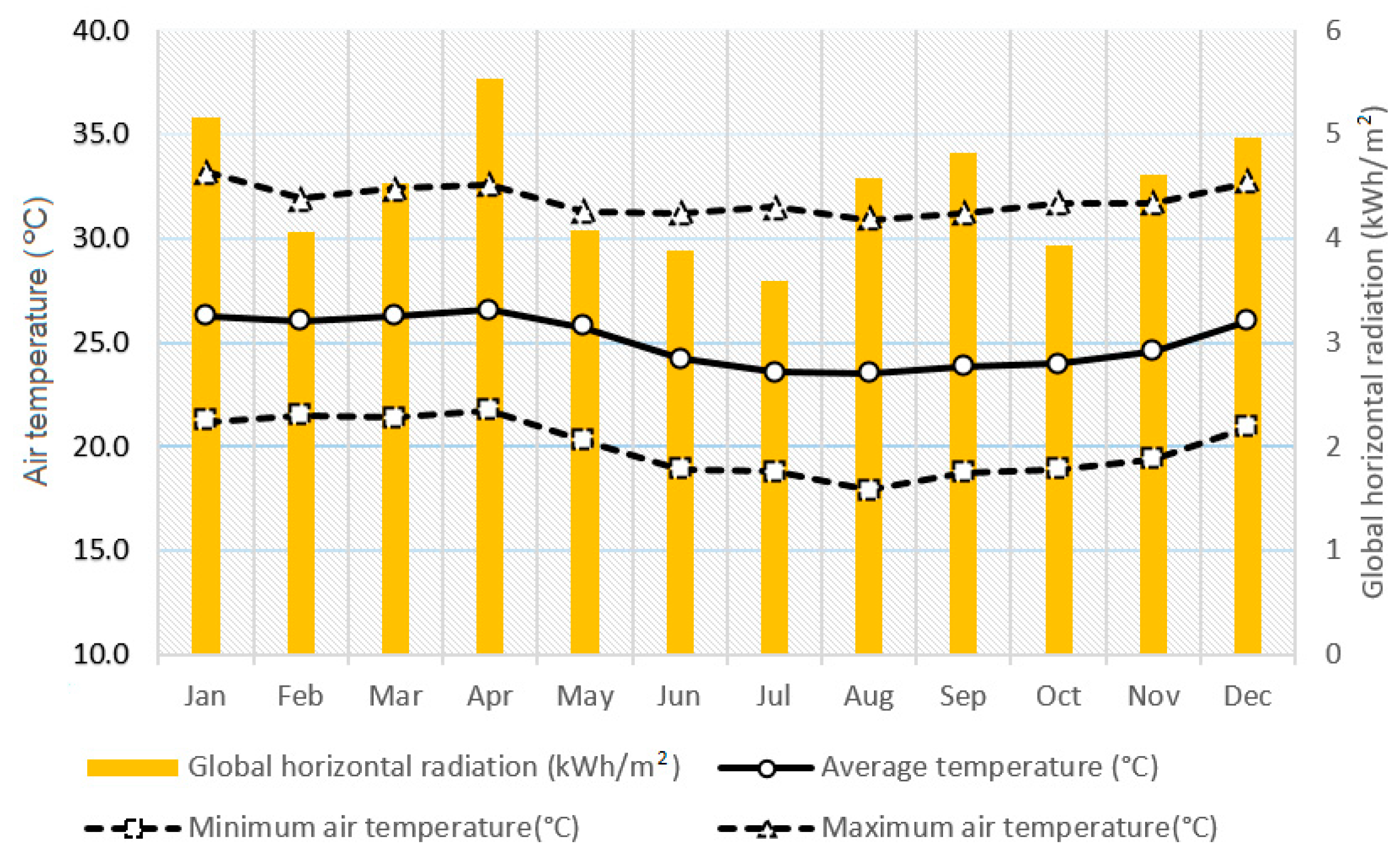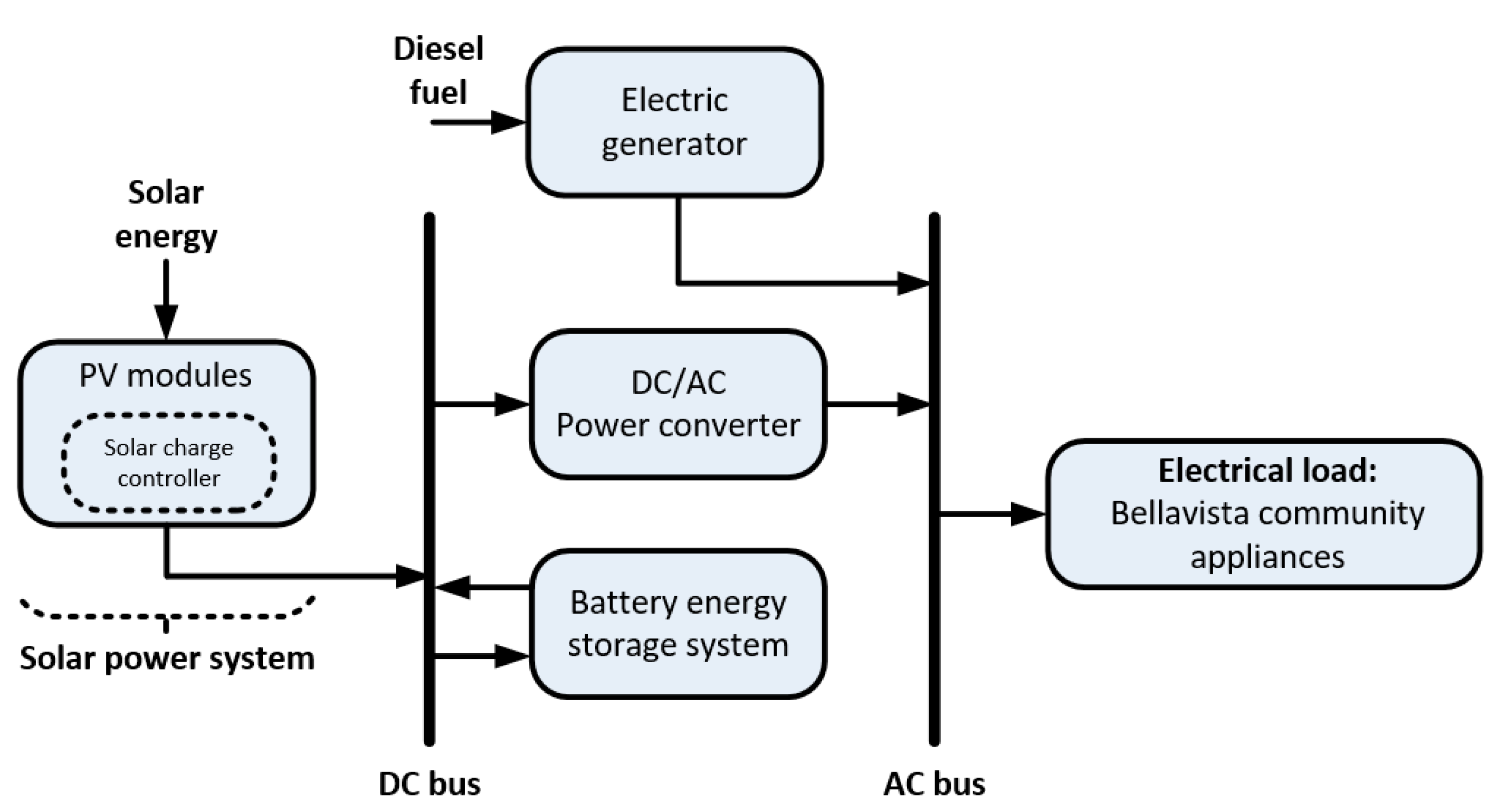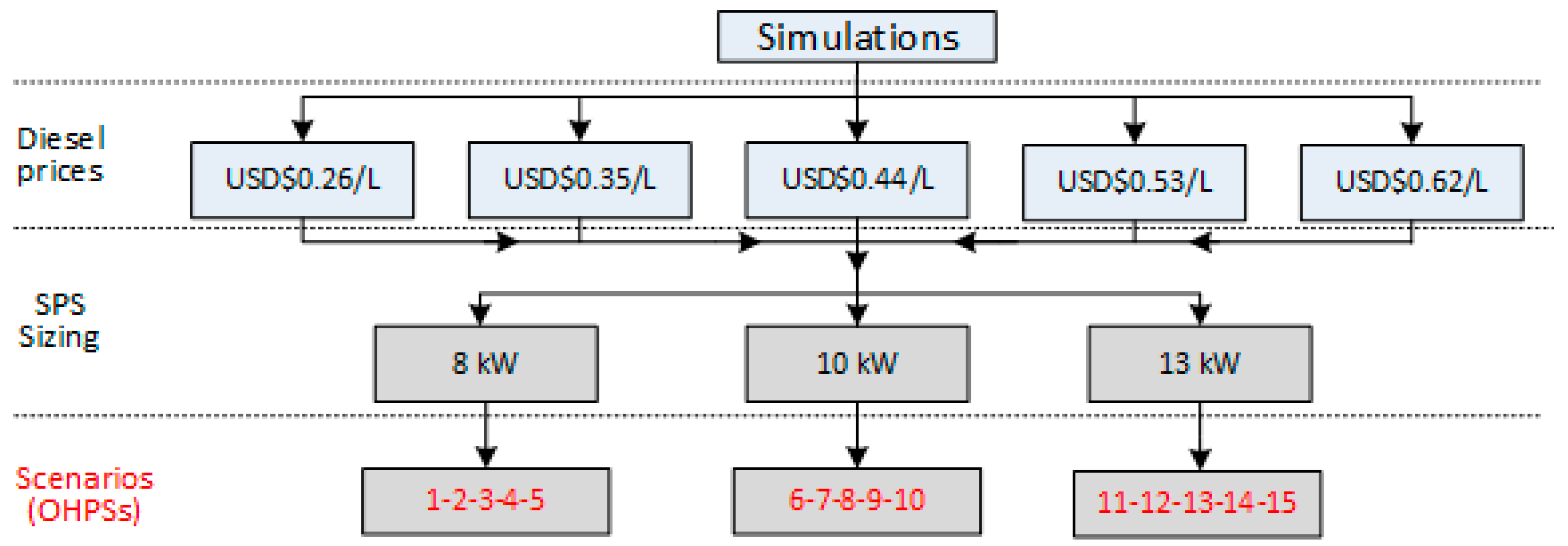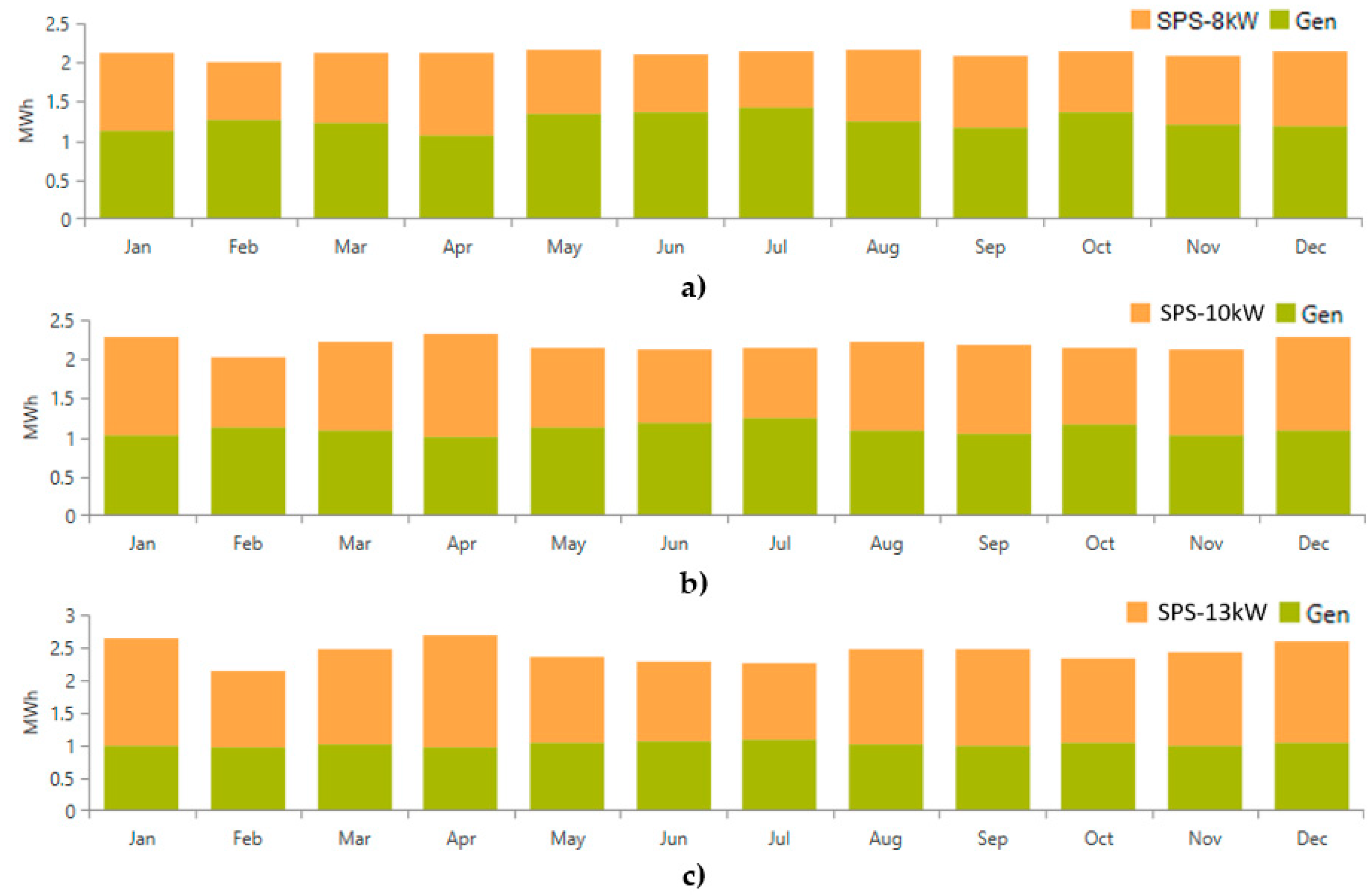Impact of the Reduction of Diesel Fuel Subsidy in the Design of an Off-Grid Hybrid Power System: A Case Study of the Bellavista Community in Ecuador
Abstract
1. Introduction
2. Literature Review
3. Methodology
3.1. Site Location
3.2. Climate Conditions
3.3. Load Profile
3.4. Design Configuration of an Off-Grid Hybrid Power System
3.5. Modeling in Homer Pro
3.5.1. Solar Power System
3.5.2. Battery Energy Storage System (BESS)
3.5.3. Net Present Cost (NPC)
3.5.4. Cost of Energy (COE)
3.5.5. Renewable Fraction ()
3.6. Model Input Data
- The system’s fixed costs were considered to be USD$35,000, where these costs included solar charge controllers, energy management system (EMS), transportation of equipment to the community (via boat), their assembly, electrical wiring, etc.
- The real interest rate was 8% with a simulation horizon of 15 years.
- The SPSs for the OHPS change in three sizes, which are 8 kW, 10 kW, and 13 kW. The photovoltaic (PV) module used in Homer Pro has the characteristics found in [21]. The derating factor considered for each PV module of the SPS was 90% and a temperature effect on the power generation of −0.35%/C. Likewise, the degradation module was considered to be 0.32%/year.
- The fuel prices considered were USD$0.26/L, USD$0.35/L, USD$0.44/L, USD$0.53/L, and USD$0.62/L.
- The proposed battery was valve-regulated lead–acid (VRLA) which typically has a nominal voltage of 2 V and is maintenance-free [24]. The operating voltage of the DC bus is 48 V; thus, the BESS had 24 batteries. The minimum state of charge of the BESS is 20% and the maximum 100%.
- The hourly data of the load profile, average air temperature, and global horizontal radiation of the community were loaded into the Homer Pro according to the information in Section 3.2 and Section 3.3.
- The dispatch strategy used in the Homer Pro is load following (LF).
3.7. Fuel Characteristics
3.8. Simulation Scenarios
4. Results
4.1. Summary of Costs of the Scenarios
4.2. Energy Production of the Generator
4.3. Comparison between the Electricity Production of the SPS and DG
4.4. Analysis of Configurations with Fuel Price of USD$0.44/L in the 15th Year of the Project
4.4.1. Operating Parameters of the Hybrid Systems
4.4.2. CO2 Emissions for the Duration of the Project
5. Discussion
6. Conclusions
Author Contributions
Funding
Institutional Review Board Statement
Informed Consent Statement
Data Availability Statement
Acknowledgments
Conflicts of Interest
Abbreviations
| OHPS | Off-grid hybrid power system |
| DG | Diesel generator |
| BESS | Battery energy storage system |
| SPS | Solar power system |
| CO2 | Carbon dioxide |
| SDGs | Sustainable Development Goals |
| COVID-19 | Coronavirus disease |
| GHG | Greenhouse gas |
| NREL | National Renewable Energy Laboratory |
| COE | Cost of Energy |
| NPC | Net Present Cost |
| ABC | Artificial Bee Colony |
| LCOE | Levelized cost of energy |
| DER | Distributed Energy Resource |
| GPS | Global Positioning System |
| masl | Meters above sea level |
| LED | Light-emitting diode |
| BSh | Hot semi-arid climate |
| DC | Direct current |
| AC | Alternating current |
| PV | Photovoltaic |
| Ren.Frac. | Renewable fraction |
| O&M | Operation and Maintenance |
| EMS | Energy management system |
| LF | Load following |
| VRLA | Valve regulated lead-acid |
References
- United Nations and Wbcsd. SDG 7: Ensure Access to Affordable, Reliable, Sustainable and Modern Energy for All. Available online: https://sdgcompass.org/wp-content/uploads/2016/04/Goal_7.pdf (accessed on 6 March 2021).
- Eroğlu, H. Effects of Covid-19 outbreak on environment and renewable energy sector. Environ. Dev. Sustain. 2020, 1–9. [Google Scholar] [CrossRef] [PubMed]
- Gillingham, K.T.; Knittel, C.R.; Li, J.; Ovaere, M.; Reguant, M. The Short-run and Long-run Effects of Covid-19 on Energy and the Environment. Joule 2020, 4, 1337–1341. [Google Scholar] [CrossRef] [PubMed]
- Bahramara, S.; Moghaddam, M.P.; Haghifam, M. Optimal planning of hybrid renewable energy systems using HOMER: A review. Renew. Sustain. Energy Rev. 2016, 62, 609–620. [Google Scholar] [CrossRef]
- Hidalgo, R.; Jacome, P.; Urquizo, J.; Soriano, G. Microgrid design for remote location in chile using a scenario-based methodology. In Proceedings of the 14th LACCEI International Multi-Conference for Engineering, Education, and Technology: Engineering Innovations for Global Sustainability, Boca Raton, FL, USA, 20–22 July 2016; pp. 20–22. [Google Scholar]
- Urquizo, J.; Singh, P.; Hidalgo-León, R.; Villavicencio, V.; Soriano, G. Rehabilitation of Solar Home Systems and Sustainable Development for an Island Community in Ecuador. In Proceedings of the 2019 IEEE Global Humanitarian Technology Conference (GHTC), Montego Bay, Jamaica, 24–26 July 2019; pp. 1–8. [Google Scholar]
- Lau, K.Y.; Yousof, M.; Arshad, S.; Anwari, M.; Yatim, A. Performance analysis of hybrid photovoltaic/diesel energy system under Malaysian conditions. Energy 2010, 35, 3245–3255. [Google Scholar] [CrossRef]
- Lipu, M.S.H.; Hafiz, M.G.; Ullah, M.S.; Hossain, A.; Munia, F.Y. Design optimization and sensitivity analysis of hybrid renewable energy systems: A case of Saint Martin Island in Bangladesh. Int. J. Renew. Energy Res. IJRER 2017, 7, 988–998. [Google Scholar]
- Shezan, S.A.; Julai, S.; Kibria, M.A.; Ullah, K.R.; Saidur, R.; Chong, W.T.; Akikur, R.K. Performance analysis of an off-grid wind-PV (photovoltaic)-diesel-battery hybrid energy system feasible for remote areas. J. Clean. Prod. 2016, 125, 121–132. [Google Scholar] [CrossRef]
- Singh, S.; Singh, M.; Kaushik, S.C. Feasibility study of an islanded microgrid in rural area consisting of PV, wind, biomass and battery energy storage system. Energy Convers. Manag. 2016, 128, 178–190. [Google Scholar] [CrossRef]
- Yuan, C.; Illindala, M.S.; Khalsa, A.S. Co-optimization scheme for distributed energy resource planning in community microgrids. IEEE Trans. Sustain. Energy 2017, 8, 1351–1360. [Google Scholar] [CrossRef]
- CIEC-ESPOL. Boletin de Politica Economica Nro. 6 Politica Fiscal y Monetaria. Centro de Investigaciones Económicas. Available online: http://www.ciec.espol.edu.ec/sites/default/files/BPE%206%20julio%20-%20DIGITAL.pdf (accessed on 29 January 2020).
- Global PetrolPrices. Diesel Prices, Liter. Available online: https://es.globalpetrolprices.com/dieselprices/ (accessed on 13 July 2020).
- Ventosa, I.P.; Sojos, A.M.; del Pozo, Z.V.; Vela, G.C.; Rivera, P.Á. Subsidios a los combustibles fósiles en Ecuador: Diagnosis y opciones para su progresiva reducción. REVIBEC-Rev. Iberoam. Econ. ECOLÓGICA 2018, 87–106. [Google Scholar]
- Homer Pro. Hybrid Optimization Model for Multiple Energy Resources. Available online: https://www.homerenergy.com/products/pro/index.html (accessed on 29 October 2020).
- Panchana, G.; Valverde, R. Diseño del Sistema de Energización Autónomo de la Isla Bellavista, localizada en el Golfo de Guayaquil; ESPOL: Guayaquil, Ecuador, 2018. [Google Scholar]
- Peel, M.C.; Finlayson, B.L.; McMahon, T.A. Updated world map of the Köppen-Geiger climate classification. Hydrol. Earth Syst. Sci. 2007, 11, 1633–1644. [Google Scholar] [CrossRef]
- Centro de Energías Renovables y Alternativas. Weather Report for the Bellavista Community. METEONORM V.7.3. Available online: https://meteonorm.meteotest.ch/en/meteonorm-version-8 (accessed on 13 July 2020).
- Amoroso, F.; Hidalgo-León, R.; Litardo, J.; Urquizo, J.; Villavicencio, V.; Torres, M.; Singh, P.; Soriano, G. Simulation of an off-grid solar system to provide reliable energy access to the Island Community of Bellavista in Ecuador. In 2020 IEEE ANDESCON; IEEE: Piscataway Township, NJ, USA, 2020; pp. 1–6. [Google Scholar]
- Yimen, N.; Hamandjoda, O.; Meva’a, L.; Ndzana, B.; Nganhou, J. Analyzing of a photovoltaic/wind/biogas/pumped-hydro off-grid hybrid system for rural electrification in Sub-Saharan Africa—Case study of Djoundé in Northern Cameroon. Energies 2018, 11, 2644. [Google Scholar] [CrossRef]
- Maxeon Solar Technologies. Sun Power Maxeon 2—360W. Singapore, 2020. Available online: https://www.europe-solarstore.com/download/sunpower/SunPower_SPR-MAX2-360_Datasheet_EN.pdf (accessed on 3 February 2021).
- MODASA. Grupo Electrogéno MP-10. Available online: https://modasa.com.pe/sistema-energia/grupos-electrogenos/24630/pdf/ (accessed on 22 February 2021).
- SMA. Sunny Island 4.4M/6.0H/8.0H for On-Grid and Off-Grid Applications. Available online: https://www.europe-solarstore.com/download/sma/SMA_Sunny_Island_4.4M_6.0H_8.0H_DATASHEET.pdf (accessed on 22 February 2021).
- HOPPECKE. OPzV Solar.Power Valve Regulated Lead-Acid Batteries for Cyclic Applications. Available online: https://www.europe-solarstore.com/download/hoppecke/opzv/OPzV_solar.power_en.pdf (accessed on 22 February 2021).
- Chávez, G.C.; Romo, S.M.; Moya, J.V.; Reyes, R.S. Composición elemental de mezclas biodiésel-diésel y análisis de sus emisiones de combustión. FIGEMPA Investig. Desarro. 2017, 1, 21–28. [Google Scholar] [CrossRef]
- Olatomiwa, L.; Mekhilef, S.; Huda, A.N.; Sanusi, K. Techno-economic analysis of hybrid PV–diesel–battery and PV–wind–diesel–battery power systems for mobile BTS: The way forward for rural development. Energy Sci. Eng. 2015, 3, 271–285. [Google Scholar] [CrossRef]
- Rousis, A.O.; Tzelepis, D.; Konstantelos, I.; Booth, C.; Strbac, G. Design of a hybrid AC/DC microgrid using HOMER Pro: Case study on an islanded residential application. Inventions 2018, 3, 55. [Google Scholar] [CrossRef]
- Hidalgo-León, R.; Siguenza, D.; Sanchez, C.; León, J.; Jácome-Ruiz, P.; Wu, J.; Ortiz, D. A survey of battery energy storage system (BESS), applications and environmental impacts in power systems. In Proceedings of the 2017 IEEE Second Ecuador Technical Chapters Meeting (ETCM), Salinas, Ecuador, 16–20 October 2017; pp. 1–6. [Google Scholar]
- Vaca-Revelo, D.; Ordoñez, F.; Mapa Solar del Ecuador 2019. Escuela Politecnica Nacional. Available online: https://www.researchgate.net/publication/338843581_Mapa_Solar_del_Ecuador_2019 (accessed on 15 February 2021).
- Villavicencio, V.; Hidalgo-León, R.; Urquizo, J.; Litardo, J.; Lema, A.; Singh, P.; Soriano, G. Impact Assessment of Solar Home System Rehabilitation in the Rural Community ‘Cerrito de los Morrenos’, Ecuador. In Proceedings of the 2020 IEEE Global Humanitarian Technology Conference (GHTC), Seattle, WA, USA, 29 October–1 November 2020. [Google Scholar]
- Litardo, J.; Palme, M.; Hidalgo-León, R.; Amoroso, F.; Soriano, G. Energy Saving Strategies and On-Site Power Generation in a University Building from a Tropical Climate. Appl. Sci. 2021, 11, 542. [Google Scholar] [CrossRef]









| Load Sector | Appliances | Power (kW/Unit) | Quantity |
|---|---|---|---|
| Home sector | Computer | 0.065 | 1 |
| LED light | 0.009 | 88 | |
| Washing machine | 0.400 | 18 | |
| Cellphone | 0.015 | 15 | |
| Electric iron | 1.200 | 1 | |
| Refrigerator | 0.025 | 8 | |
| TV | 0.095 | 22 | |
| DVD player | 0.010 | 11 | |
| Street lighting | LED light | 0.150 | 8 |
| School | Computer | 0.065 | 1 |
| LED light | 0.018 | 16 | |
| Health center | LED light | 0.018 | 8 |
| Church | LED light | 0.018 | 8 |
| Components | Capacity | Capital Cost (USD$) | Replacement Cost (USD$/kW) | O&M Cost (USD$/op.hour) | Estimated Lifetime (Years) | Efficiency (%) |
|---|---|---|---|---|---|---|
| PV module | 0.36 kW | 220 | 0.00 | 0.00 | 20 | 20 |
| DG | 10 kW | 8900 | 0.00 | 0.25 | 20 | 31 |
| DC/AC power converter | 6 kW | 8625 | 8625 | 0.00 | 8 | 95 |
| BESS | 750 Ah | 885 | 885 | 0.00 | 8-12 | 85 |
| Fuel | Lower Heating Value (MJ/kg) | Density (kg/m3) | Carbon Content (%) | Sulfur Content (%) |
|---|---|---|---|---|
| Diesel | 43.96 | 880 | 81.21 | 0.184 |
| Scenario | Fuel Price (USD$) | SPS Size (kW) | NPC (USD$) | COE (USD$/kWh/year) | Mean Operating Cost (USD$/year) | Mean Fuel Cost (USD$/year) |
|---|---|---|---|---|---|---|
| 1 | 0.26 | 8 | 102,027 | 0.559 | 2731 | 1576 |
| 6 | 10 | 102,444 | 0.562 | 2637 | 1538 | |
| 11 | 13 | 103,515 | 0.567 | 2548 | 1501 | |
| 2 | 0.35 | 8 | 104,339 | 0.572 | 3001 | 1837 |
| 7 | 10 | 104,478 | 0.573 | 2874 | 1774 | |
| 12 | 13 | 105,422 | 0.578 | 2770 | 1726 | |
| 3 | 0.44 | 8 | 107,730 | 0.591 | 3397 | 1995 |
| 8 | 10 | 107,133 | 0.587 | 3184 | 1720 | |
| 13 | 13 | 107,467 | 0.589 | 3009 | 1582 | |
| 4 | 0.53 | 8 | 111,373 | 0.611 | 3823 | 2409 |
| 9 | 10 | 110,260 | 0.604 | 3550 | 2062 | |
| 14 | 13 | 110,303 | 0.611 | 3341 | 1883 | |
| 5 | 0.62 | 8 | 114,881 | 0.630 | 4232 | 2820 |
| 10 | 10 | 113,280 | 0.621 | 3903 | 2413 | |
| 15 | 13 | 113,053 | 0.620 | 3662 | 2202 |
| Scenario | Fuel Price (USD$/L) | SPS Size (kW) | Converter Mean Energy Output (kWh/year) | Mean Generator Production (kWh/year) | Mean BESS Energy Output (kWh/year) | Mean Fuel Consumption (L/year) | Mean Ren. Frac. (%) |
|---|---|---|---|---|---|---|---|
| 1 | 0.26 | 8 | 4819 | 16,792 | 1572 | 6121 | 22.3 |
| 2 | 0.35 | 6441 | 15,246 | 2725 | 5483 | 29.7 | |
| 3 | 0.44 | 8422 | 13,229 | 4688 | 4652 | 38.9 | |
| 4 | 0.53 | 8374 | 13,264 | 4714 | 4666 | 38.7 | |
| 5 | 0.62 | 8377 | 13,269 | 4711 | 4668 | 38.7 | |
| 6 | 0.26 | 10 | 5253 | 16,363 | 1391 | 5970 | 24.3 |
| 7 | 0.35 | 6923 | 14,779 | 2554 | 5318 | 31.9 | |
| 8 | 0.44 | 10,074 | 11,591 | 5250 | 4003 | 46.5 | |
| 9 | 0.53 | 10,133 | 11,519 | 5352 | 3974 | 46.8 | |
| 10 | 0.62 | 10,097 | 11,524 | 5355 | 3976 | 46.7 | |
| 11 | 0.26 | 13 | 5706 | 15,908 | 1199 | 5823 | 26.4 |
| 12 | 0.35 | 6724 | 14,355 | 2336 | 5183 | 31.9 | |
| 13 | 0.44 | 10,963 | 10,703 | 5315 | 3677 | 50.6 | |
| 14 | 0.53 | 11,104 | 10,541 | 5476 | 3611 | 51.3 | |
| 15 | 0.62 | 11,103 | 10,540 | 5482 | 3610 | 51.3 |
Publisher’s Note: MDPI stays neutral with regard to jurisdictional claims in published maps and institutional affiliations. |
© 2021 by the authors. Licensee MDPI, Basel, Switzerland. This article is an open access article distributed under the terms and conditions of the Creative Commons Attribution (CC BY) license (http://creativecommons.org/licenses/by/4.0/).
Share and Cite
Hidalgo-Leon, R.; Amoroso, F.; Litardo, J.; Urquizo, J.; Torres, M.; Singh, P.; Soriano, G. Impact of the Reduction of Diesel Fuel Subsidy in the Design of an Off-Grid Hybrid Power System: A Case Study of the Bellavista Community in Ecuador. Energies 2021, 14, 1730. https://doi.org/10.3390/en14061730
Hidalgo-Leon R, Amoroso F, Litardo J, Urquizo J, Torres M, Singh P, Soriano G. Impact of the Reduction of Diesel Fuel Subsidy in the Design of an Off-Grid Hybrid Power System: A Case Study of the Bellavista Community in Ecuador. Energies. 2021; 14(6):1730. https://doi.org/10.3390/en14061730
Chicago/Turabian StyleHidalgo-Leon, Ruben, Fernando Amoroso, Jaqueline Litardo, Javier Urquizo, Miguel Torres, Pritpal Singh, and Guillermo Soriano. 2021. "Impact of the Reduction of Diesel Fuel Subsidy in the Design of an Off-Grid Hybrid Power System: A Case Study of the Bellavista Community in Ecuador" Energies 14, no. 6: 1730. https://doi.org/10.3390/en14061730
APA StyleHidalgo-Leon, R., Amoroso, F., Litardo, J., Urquizo, J., Torres, M., Singh, P., & Soriano, G. (2021). Impact of the Reduction of Diesel Fuel Subsidy in the Design of an Off-Grid Hybrid Power System: A Case Study of the Bellavista Community in Ecuador. Energies, 14(6), 1730. https://doi.org/10.3390/en14061730











